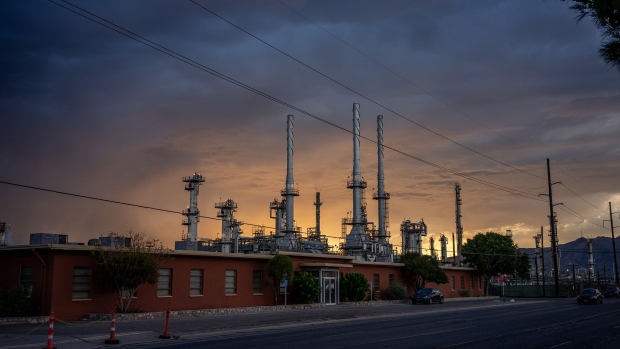Oct 2, 2023
Nearly 2.5 Million Barrels a Day of US Refining Capacity to Shut for Fall Maintenance
, Bloomberg News

(Bloomberg) -- The fall refinery maintenance season in the US is shaping up to be the heaviest since before the Covid-19 pandemic forced plants to slash rates and delay all but emergency work.
Nearly 2.5 million barrels a day of refining capacity will go offline for maintenance from September through December, according to data from Energy Aspects LTD. That’s 11% higher than the same period last year.
Looking ahead, the first quarter of 2024 is projected by some to be the heaviest maintenance season ever, loaded with deferred work and regularly scheduled turnarounds on crude units, gasoline-making fluid catalytic crackers, cokers and others. That could kick-start a race to lock down available contractors.
This fall’s packed schedule is partly a result of repairs on units hobbled by unplanned leaks, multiple fires and the overall stress of running hard during an unusually hot summer. Refiners also must work through a backlog of turnarounds after delaying maintenance to save money during the pandemic and, later, to chase strong margins as the economy improved.
“In 2023, we’re seeing a lot of unplanned outages,” said Austin Lin, principal analyst for refining and oil markets at Wood Mackenzie. “There’s been a continued tendency to defer and minimize maintenance where possible.”
Now, as refining margins come off their highs, plants can start going down for repairs. The 3-2-1 futures crack spread has slipped to about $23 a barrel Monday, down from more than $43 on Aug. 11. While diesel margins remain relatively strong, those for gasoline are plunging with summer’s end.
Routine maintenance like changing out catalysts and cleaning out cokers has to be done regularly. Full turnarounds that traditionally occur every 4-6 years can only be postponed for so long without risking chronic upsets that can shut units down for weeks.
“The day of reckoning has come,” said Andy Lipow, president of Lipow Oil Associates in Houston. “Now they have to do maintenance.”
As of Friday, an average of 526,000 barrels per day of US processing capacity was expected to be offline for planned work in September, 1.48 million barrels in October, 452,000 barrels in November and nothing in December, according to Energy Aspects. The data only include confirmed maintenance. Actual amounts will likely swell if more work is added or unplanned shutdowns occur from unit upsets, power glitches or storms.
Shell’s Norco refinery north of New Orleans pushed a turnaround on its sole crude unit to late September from a late March start because product margins were robust, a person familiar with operations said. Exxon Baytown and Motiva Port Arthur in Texas also began maintenance on big crude units last week.
The pandemic taught refiners many hard lessons about the unpredictability of the market, with the US losing about 1.2 million barrels of capacity from outright closures between 2019 and 2022. Another 300,000 barrels were lost because of upgrades to add capacity that never happened, said Robert Auers, manager of Refined Fuels Analytics, a division of RBN Energy.
One unknown every fall is whether a major tropical storm will take out more capacity on the US Gulf Coast during the Atlantic Hurricane season. The last year that Gulf production areas were spared a tropical storm strike, which can knock out large amounts of production for days at a time, was 2014.
--With assistance from Chunzi Xu, Lucia Kassai and Brian K. Sullivan.
©2023 Bloomberg L.P.






